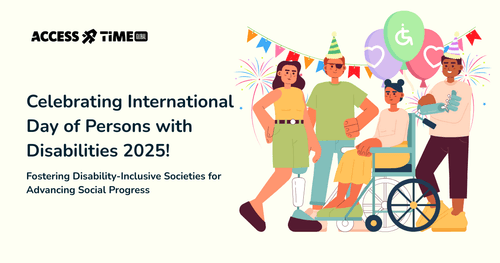Proč by se přístupnost měla stát záležitostí nás všech
Veronika Jarošová - Content Writer
●●
Už jste se někdy pokoušeli rezervovat si let online, ale tlačítka na webu byla tak malá, že na telefonu skoro nejdou stisknout, text byl tak světlý, že jste ho sotva přečetli, a bez myši nebylo možné se vůbec pohybovat?
Frustrující, že?
Teď si představte, že tohle je vaše každodenní realita – protože máte zrakové nebo pohybové postižení. Právě tady přichází ke slovu přístupnost. A proto to není problém, který by měl řešit jen jeden člověk.
Co je to vlastně přístupnost (a proč je důležitější, než si myslíte)
Začněme jednoduše a jasně, jako za slunečného dne. Přístupnost webu znamená, že jsosu weby a aplikace použitelné pro všechny – včetně lidí s postižením. V reálném světě si to představte jako stavbu rampy vedle schodů. Schody zůstávají, ale zároveň zajistíte, že se na stejné místo dostanou všichni bez rozdílu.
Jenže většina lidí si neuvědomuje, že přístupnost prospívá úplně všem. Nevěříte? Pojďme si projít pár příkladů bez nálepky „přístupný web“.
- Ty titulky, které si zapínáte při sledování videí v hlučné kavárně? To je přístupnost.
- Hlasové ovládání, které používáte při řízení? Taky přístupnost.
Když navrhujeme pro lidi s postižením, často nakonec vytváříme lepší zážitek úplně pro všechny.
A čísla mluví sama za sebe.
Více než 1,3 miliardy lidí na světě žije s nějakou formou postižení –
to je asi 16 % světové populace!
.
Z pohledu byznysu jde o obrovský tržní segment, o který opravdu nechcete přijít. Navíc v mnoha zemích už přístupnost není jen morální povinnost, ale i zákonný požadavek.
Proč přístupnost nelze „dodat až v kódu“
Tradičně se k přístupnosti přistupovalo jako k rychlé opravě na poslední chvíli. Design je hotový, texty napsané, uživatelské cesty nakreslené – a pak si někdo vzpomene:
„Hele, a můžeš to udělat přístupné?“
Jako by šlo jen o přepínač v nastavení.
Přístupnost se však nedá „posypat navrch“ jako koření. Je to spíš jako základy domu – musí se s ní počítat od samého začátku.
Když se zodpovědnost za přístupnost přehodí jen na vývojáře, vzniká hned několik problémů:
-
Vývojáři dědí rozhodnutí, která sami neudělali.
Pokud designér zvolí barevnou paletu s nízkým kontrastem, nebo copywriter vytvoří matoucí navigační názvy, vývojář je v pasti a snaží se zachránit něco, co je špatně už od základu. Je to jako chtít po šéfkuchaři skvělé jídlo, a přitom mu dát jen zkažené suroviny.
-
Opravy přístupnosti na konci jsou drahé a zdlouhavé.
Často vyžadují redesign komponent, přepis obsahu nebo dokonce kompletní přepracování uživatelských cest. Co se dalo snadno předejít včas, se stává nákladným dodatečným řešením.
A to nejdůležitější je, že tento přístup přehlíží podstatu. Vývojáři mohou zajistit, aby čtečky obrazovky správně procházely kód, ale nemohou napravit nejasný obsah, nelogické uživatelské cesty ani designové vzory, které část uživatelů vylučují. Přístupnost je ve své podstatě o uživatelské zkušenosti – ne jen o technické implementaci. Přístupnost tedy není jednorázová úprava v kódu – je to způsob, jak od začátku myslet na všechny uživatele.
Posuňme dál sílu společné odpovědnosti

Co se stane, když přístupnost vezmou za svou všichni?
Kouzlo. Přesně to.
Když
designéři
myslí na přístupnost už od začátku, volí barevné palety s dostatečným kontrastem, vytvářejí rozvržení, která fungují i při různých úrovních přiblížení, a navrhují jasnou vizuální hierarchii. Uvažují o tom, jak jejich rozhodnutí ovlivní uživatele s různými schopnostmi, a záměrně volí řešení, která zahrnují – místo aby vylučovala.
Když
autoři obsahu a copywriteři
(ano, to jsem já!) upřednostňují přístupnost, píšou jasné texty bez zbytečného žargonu, používají popisné texty odkazů místo generických „klikněte zde“ a strukturovaně dělí obsah pomocí správně použitých nadpisů. Vědí, že právě jejich slova jsou často hlavním způsobem, jakým se uživatelé na webu orientují a jak mu rozumí.
Když
UX designéři a výzkumníci
začleňují přístupnost do svého procesu, testují s různorodými skupinami uživatelů, vytvářejí uživatelské cesty fungující pro různé způsoby interakce a navrhují funkce, které jsou intuitivní i pro lidi s odlišnými kognitivními schopnostmi.
Když
produktoví manažeři
prosazují přístupnost, vyhrazují pro ni dostatek času a zdrojů, zahrnují ji do definice „hotovo“ a dbají na to, aby požadavky na přístupnost byly jasné od samého začátku projektu. Uvědomují si, že přístupnost není oprava chyby, ale plnohodnotná funkce.
Když
tým pro kontrolu kvality
zahrne do procesu i přístupnost, dokáže odhalit problémy dříve, než se dostanou k uživatelům. Pracuje s asistivními technologiemi a ví, jak má vypadat a fungovat opravdu přístupný produkt.
A ano – když
jsou vývojáři
součástí tohoto spolupracujícího přístupu, místo aby nesli celou tíhu sami, mohou se soustředit na správné provedení přístupnosti, ne na náročné dohánění chyb způsobených rozhodnutími „upstream“.
Od individuální zátěže k týmové supermoci
Krása společné odpovědnosti spočívá v tom, že nevyžaduje, aby se z každého přes noc stal expert na přístupnost. Začíná to povědomím a roste spoluprací.
Začněte tím, že začleníte přístupnost do stávajících procesů:
- Při designových revizích se ptejte: „Jak bude tohle fungovat pro uživatele, kteří nerozlišují barvy?“
- Při revizi obsahu se ptejte: „Je tenhle text srozumitelný i pro uživatele s kognitivnímipotížemi?“
- Při plánování vývoje zahrňte úkoly týkající se přístupnosti hned vedle nových funkcí – ne až dodatečně.
Vytvořte napříč týmy „šampiony přístupnosti“ – lidi, kteří se naučí o něco víc a dokážou kolegům poradit. Tito šampioni pak sdílejí znalosti, včas zachytávají potenciální problémy a podporují inkluzivní postupy ve své specializaci.
A co je nejdůležitější – začněte hodnotit přístupnost stejně jako ostatní ukazatele kvality. Sledujete rychlost načítání stránek nebo míru konverzí? Pak sledujte i plnění požadavků na přístupnost a spokojenost uživatelů s postižením.
Co se měří, to se zlepšuje.
Vlnový efekt inkluzivního myšlení
Když týmy přijmou společnou odpovědnost za přístupnost, stane se něco pozoruhodného. Společně začnou přemýšlet inkluzivněji úplně o všem. Uvažují o uživatelích v různých kontextech, s různými potřebami a různými způsoby práce s technologií. Tento inkluzivní přístup pak přináší inovace a vylepšení, která prospívají všem.
Týmy, které dávají přístupnosti prioritu, často zjistí, že vytvářejí i robustnější, flexibilnější a uživatelsky přívětivější produkty. Píšou jasnější texty, navrhují intuitivnější rozhraní a budují spolehlivější technická řešení. Přístupnost se tak stává měřítkem kvality – ne jen shodou s předpisy.
Půjdeme dál – společně?
Nemusíte na to být sami. Ať už jste na začátku cesty, nebo chcete posunout stávající postupy na vyšší úroveň, existují zdroje, které vám pomohou právě tam, kde jste.
Pokud vás zajímá, jak si váš web aktuálně stojí, zkuste zdarma audit s Access Lens který je zatím ještě v beta verzi. Je to skvělý způsob, jak získat základní přehled bez závazků.
Pro týmy, které chtějí jít do hloubky a vybudovat komplexní strategie přístupnosti, nabízí tým AccessTime poradenské služby, které pomohou vytvořit udržitelné, inkluzivní postupy napříč celou organizací.
Nejdůležitější krok je prostě začít.
Začněte o tom mluvit,
začněte se ptát,
a pamatujte: přístupnost není o dokonalosti, ale o pokroku.
Každý malý krok směrem k inkluzi zlepšuje něčí digitální zkušenost.
<Note>
Když přestaneme přístupnost chápat jako úkol pro jednoho člověka a začneme ji vnímat jako příležitost pro všechny tvořit lepší zážitky, dokážeme tvořit produkty, které jsou inkluzivnější, inovativnější, promyšlenější – a také úspěšnější.
</Note>
Contact Us
Ready to explore how accessibility can transform your products? Visit our contact page to learn more about AccessTime consultancy services, or try Access Lens to get started with a fresh perspective on what's possible.
Share:

